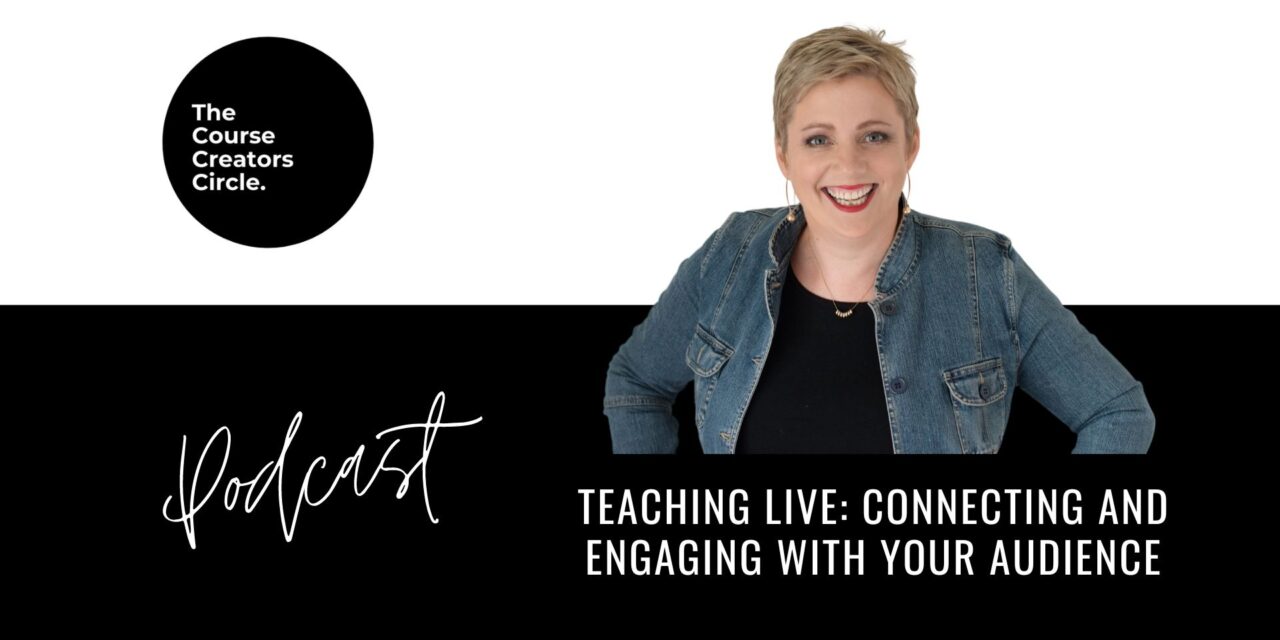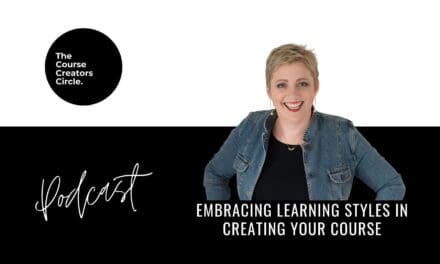Live teaching offers a rich, interactive learning experience that can be tailored to meet students’ diverse needs. By leveraging technology, preparing engaging materials, and fostering interaction, educators can create dynamic and effective live courses.
In this episode, we explore the world of live teaching, especially in the realm of course creation. Live teaching offers numerous advantages, making it a preferred approach for many educators.
Here are some of my insights, tips, and tools to enhance your live teaching experience.
Why Teach Live?
Enhanced Engagement and Interaction
Teaching live allows for real-time interaction with students. This direct engagement helps educators understand their students’ needs better, fostering a more personalised learning experience. Live sessions enable immediate feedback and adjustments, making the learning process more dynamic and responsive.
Flexibility and Adaptability
Live teaching offers the flexibility to adapt content on the fly. If students seem confused or disengaged, educators can pivot their approach, ensuring the material resonates better. This adaptability is particularly beneficial in keeping the class engaged and ensuring comprehension.
Cost-Effectiveness
Conducting live online classes eliminates the need for extensive physical resources and storage platforms. This makes it a more cost-effective solution for both educators and students.
Tips for Successful Live Teaching
Utilise Beta Courses and Webinars
Delivering beta courses or a series of webinars can be an excellent way to refine your content. These sessions can later be stitched together to form a comprehensive course. Additionally, live challenges can keep students engaged and provide valuable feedback.
Embrace the Benefits of Online Platforms
Online teaching platforms like Zoom, Google Meet, and Restream offer increased accessibility and flexibility. These platforms allow educators to reach a global audience, fostering a more inclusive and diverse learning environment.
Promote Interactive Learning Experiences
Encourage interaction through discussions, forums, and collaborative activities. This not only enhances learning but also builds a sense of community among students.
Preparing Your Live Teaching Toolkit
Reliable Technology
A stable internet connection, a good computer or laptop, and a quality camera are essential. Logitech webcams are a great choice for their ease of use and excellent video quality.
Video Conferencing Software
Choose a reliable platform like Zoom, Google Meet, or Restream. These tools provide the necessary features for effective live teaching, including screen sharing and recording capabilities.
Quality Audio
Invest in a good microphone. Options like lapel mics or the Rode NT-USB Mini can ensure clear audio, which is crucial for maintaining student engagement.
Learning Management Systems (LMS)
Use an LMS to organise and distribute your course materials. Platforms like Thinkific and Wobo can streamline this process, providing a centralised location for students to access handouts, slides, and other resources.
For a detailed list of all the tools listed here and other tools you can use for course creation, check out The Course Creator’s Toolkit.
Structuring Your Live Sessions
Set Clear Objectives: Define specific learning objectives for each session to ensure that the content aligns with your students’ needs and goals.
Prepare Engaging Materials: Create visually appealing slides, handouts, and other resources. Incorporate various learning styles to cater to visual, auditory, and kinesthetic learners.
Plan for Interaction: Encourage participation through questions, polls, and discussions. Use interactive elements to keep students engaged and facilitate deeper understanding.
Be Flexible: Be prepared to adapt your plan based on student feedback and engagement levels. Flexibility is key to a successful live teaching experience.
Collect Feedback: Gather feedback from your students after each session to understand what worked well and what could be improved. Use this information to refine future sessions.
Provide Clear Next Steps: Ensure students know what to expect next. Whether it’s the next live session or additional resources, clear communication helps maintain engagement and continuity.
By incorporating robust technology, preparing engaging materials, and fostering an interactive learning environment, educators can deliver enriching and impactful educational experiences. Embrace the flexibility and immediacy of live teaching to connect with your students more deeply, cater to diverse learning styles, and continuously improve your course offerings based on real-time feedback.
For a step-by-step guide to help you kickstart your course creation journey, check out The Course Creation Guidebook and The Course Creators Circle Hub.
Highlights
- [00:00] Teaching Live Course
- [00:52] Benefits of Live Online Teaching
- [01:50] Engaging with Students in Real-Time
- [05:40] Tools and Equipment for Live Teaching
- [07:14] Types of Live Online Training
- [09:54] Planning and Executing Live Sessions
- [12:03] Final Thoughts and Encouragement
Resources Mentioned in the Podcast
Get More Course Creation Tips in The Course Creators Circle Hub
The Course Creation Hub is for educators who love to teach what they do. Led by Thinkific Expert Linda Reed-Enever, our hub offers a wealth of tools, tips, and checklists to help you craft and market your courses with ease.
















